
Cotyledon is one of some 35 genera of succulent plants in the family Crassulaceae. Mostly from Southern Africa, they also occur throughout the drier parts of Africa as far north as the Arabian Peninsula. Ten of its species are mostly confined to South Africa, where unlike Tylecodon, they occur commonly in both the winter and summer rainfall regions. They may be found on coastal flats and rocky hillsides, or as cremnophytes on cliff faces. Their decussate, evergreen leaves are very variable in shape, even within some species, but the flowers are, apart from colour, very similar.
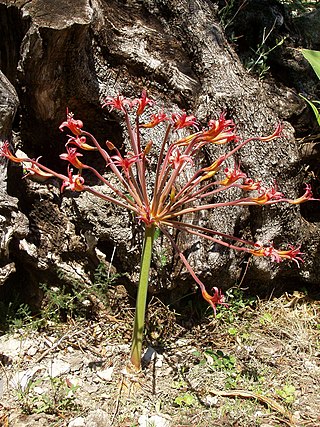
Brunsvigia is a genus of African flowering plants in the family Amaryllidaceae, subfamily Amaryllidoideae. It contains about 20 species native to southeastern and southern Africa from Tanzania to the Cape Provinces of South Africa.
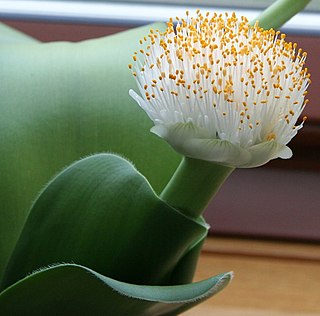
Haemanthus is a Southern African genus of flowering plants in the family Amaryllidaceae, subfamily Amaryllidoideae. Members of the genus are known as blood lily and paintbrush lily. There are some 22 known species, native to South Africa, Botswana, Namibia, Lesotho and Eswatini. About 15 species occur in the winter rainfall region of Namaqualand and the Western Cape, the remainder being found in the summer rainfall region, with one species Haemanthus albiflos occurring in both regions.

Aloidendron pillansii, formerly Aloe pillansii, the giant quiver tree or bastard quiver tree, is a large, branching species of succulent plant indigenous to southern Africa. It is regarded as critically endangered.

Namaqua National Park is a South African national park situated approximately 495 km north of Cape Town and 22 km northwest of Kamieskroon. It has an area of more than 1300 km2. The park is part of Namaqualand, an area covering 55,000 km2 located within the semi-desert Succulent Karoo biome. This biome is a biodiversity hotspot with the largest concentration of succulent plants in the world. The park also has an arid environment with succulent plants. The park was created to protect its flowers. During the spring, wildflowers bloom there in a spectacular fashion. The park's main tourist attraction is this abundant spring bloom of brightly coloured wildflowers.
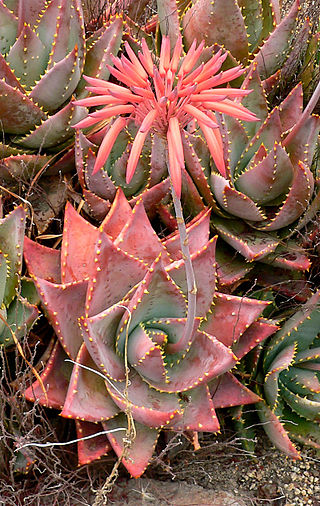
Aloe perfoliata, the rubble aloe or mitre aloe, is a hardy creeping aloe, found in rocky, mountainous areas throughout the Western Cape, South Africa.

Aloe pearsonii is a very distinctive and unusual species of aloe, that is naturally endemic to the arid Richtersveld area on the border between South Africa and Namibia.

The Stellenbosch University Botanical Garden located in the historical center of Stellenbosch is the oldest university botanical garden in South Africa. The Garden is relatively small and houses an enormous diversity of plants, both indigenous to South Africa and introduced species. It is open to the public.
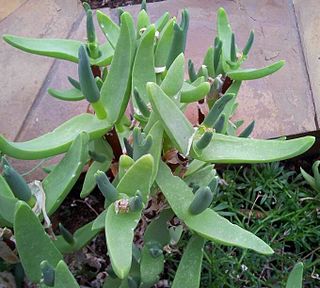
Mitrophyllum is a genus of succulent plants of the family Aizoaceae, indigenous to the arid region around the Richtersveld, on the border of South Africa and Namibia.

Crassula nudicaulis is a succulent plant native to South Africa, and Lesotho.
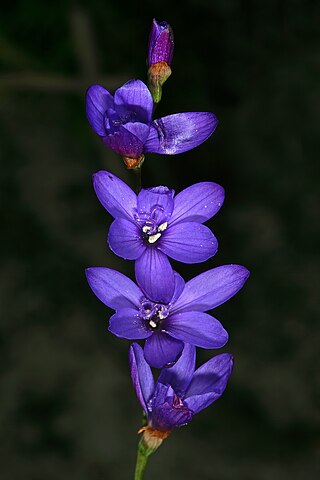
Geissorhiza aspera, also known as the blue satin flower or blou sysie, is a geophyte from South Africa.
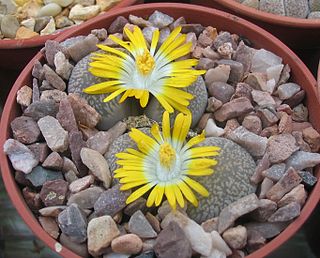
Lithops comptonii is a species of plant in the family Aizoaceae, indigenous to South Africa.

Babiana lobata is a species of geophyte of 12–25 cm (4.7–9.8 in) high that is assigned to the family Iridaceae. It has leaves that consist of a sheath and a blade that are at a slight angle with each other. The leaf blades are narrow, sword- to lance-shaped and have a left and right surface, rather than an upper and lower surface. The leaf blades are slightly pleated and hairless. The inflorescence contains seven to twelve bluish mauve mirror-symmetrical flowers comprising six tepals, with the lower lateral tepals yellow sometimes flushed mauve at their tips, and with three stamens crowding under the dorsal tepal. Flowering occurs in July and August. The flowers emit a faint acrid-metallic scent. B. lobata grows in part of the Richtersveld in the Northern Cape province of South Africa.

Stachys rugosa is a species of perennial herb in the genus Stachys.
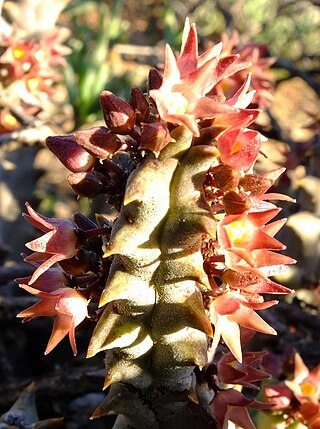
Quaqua incarnata is a species of succulent plant in the genus Quaqua. It is endemic to southwestern Namibia and to the Namaqualand region in the western Cape Provinces of South Africa.
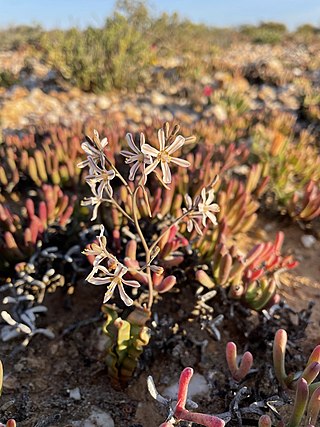
Trachyandra tortilis is a species of succulent in the genus Trachyandra. It is endemic to the Cape Provinces of South Africa.
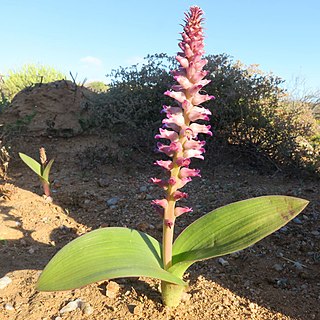
Lachenalia carnosa is a species of geophyte in the genus Lachenalia. It is endemic to the Northern Cape and Western Cape. It is also known by the names Namakwa- persviooltjie and flesh viooltjie.
Cheiridopsis purpurea is a species of succulent plant from South Africa. It is found growing in the succulent Karoo vegetation type.
Cheiridopsis pilosula is a species of succulent plant from Namaqualand in the Northern Cape of South Africa.
Cheiridopsis ponderosa is a species of succulent plant from South Africa.

















